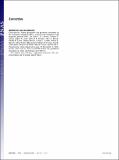Paired quantitative and qualitative assessment of the replication-competent HIV-1 reservoir and comparison with integrated proviral DNA
Author(s)
Lorenzi, Julio C. C.; Cohen, Yehuda Z.; Cohn, Lillian B.; Kreider, Edward F.; Learn, Gerald H.; Oliveira, Thiago; Lavine, Christy L.; Horwitz, Joshua A.; Settler, Allison; Jankovic, Mila; Seaman, Michael S.; Hahn, Beatrice H.; Caskey, Marina; Nussenzweig, Michel C.; Barton, John P; Chakraborty, Arup K; ... Show more Show less
DownloadE7908.full.pdf (1.133Mb)
PUBLISHER_POLICY
Publisher Policy
Article is made available in accordance with the publisher's policy and may be subject to US copyright law. Please refer to the publisher's site for terms of use.
Terms of use
Metadata
Show full item recordAbstract
HIV-1-infected individuals harbor a latent reservoir of infected CD4⁺ T cells that is not eradicated by antiretroviral therapy (ART). This reservoir presents the greatest barrier to an HIV-1 cure and has remained difficult to characterize, in part, because the vast majority of integrated sequences are defective and incapable of reactivation. To characterize the replication-competent reservoir, we have combined two techniques, quantitative viral outgrowth and qualitative sequence analysis of clonal outgrowth viruses. Leukapheresis samples from four fully ART-suppressed, chronically infected individuals were assayed at two time points separated by a 4- to 6-mo interval. Overall, 54% of the viruses emerging from the latent reservoir showed gp160 env sequences that were identical to at least one other virus. Moreover, 43% of the env sequences from viruses emerging from the reservoir were part of identical groups at the two time points. Groups of identical expanded sequences made up 54% of proviral DNA, and, as might be expected, the sequences of replication-competent viruses in the active reservoir showed limited overlap with integrated proviral DNA, most of which is known to represent defective viruses. Finally, there was an inverse correlation between proviral DNA clone size and the probability of reactivation, suggesting that replication-competent viruses are less likely to be found among highly expanded provirus-containing cell clones.
Date issued
2016-11Department
Institute for Medical Engineering and Science; Massachusetts Institute of Technology. Department of Biological Engineering; Massachusetts Institute of Technology. Department of Chemical Engineering; Massachusetts Institute of Technology. Department of Chemistry; Massachusetts Institute of Technology. Department of PhysicsJournal
Proceedings of the National Academy of Sciences
Publisher
National Academy of Sciences (U.S.)
Citation
Lorenzi, Julio C. C. et al. “Paired Quantitative and Qualitative Assessment of the Replication-Competent HIV-1 Reservoir and Comparison with Integrated Proviral DNA.” Proceedings of the National Academy of Sciences 113, 49 (November 2016): E7908–E7916
Version: Final published version
ISSN
0027-8424
1091-6490